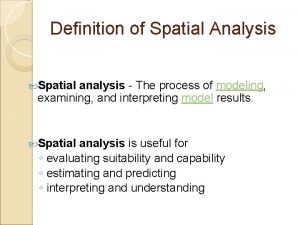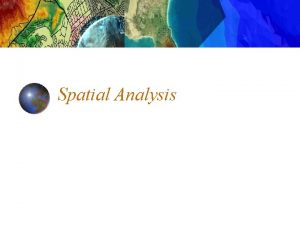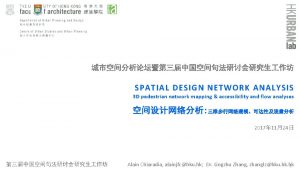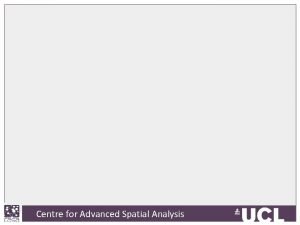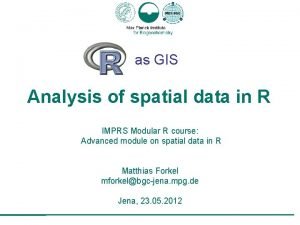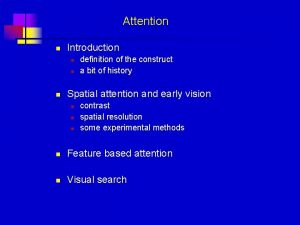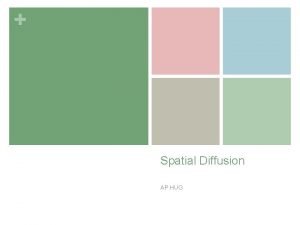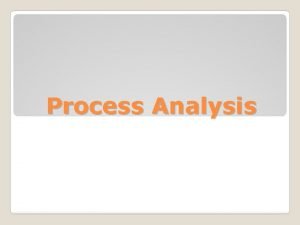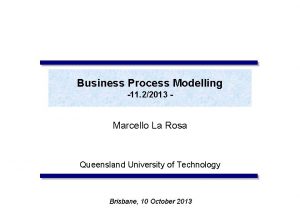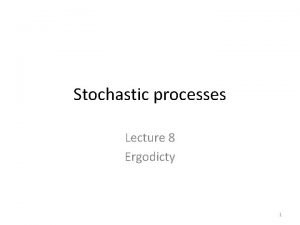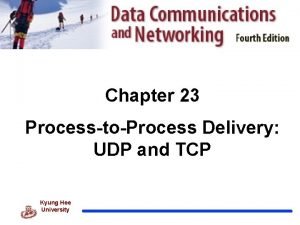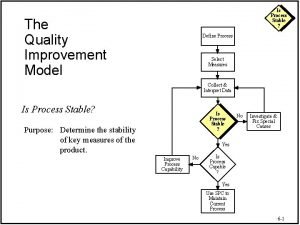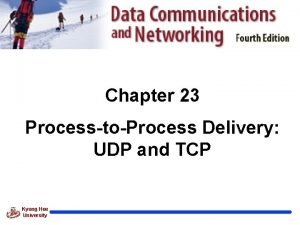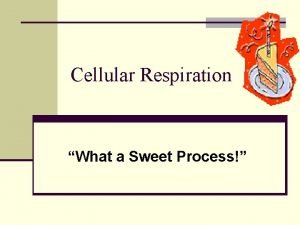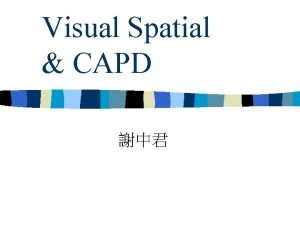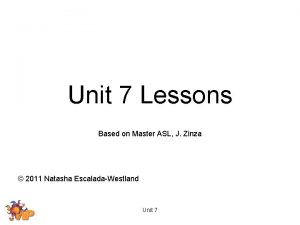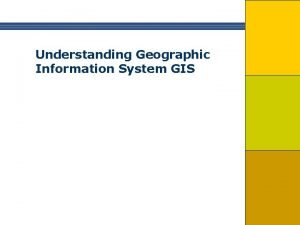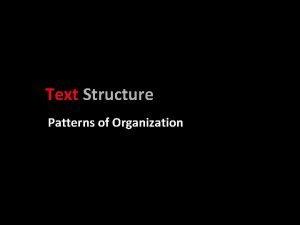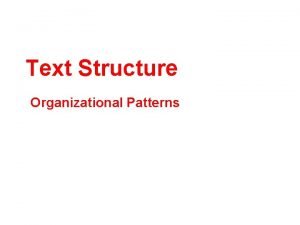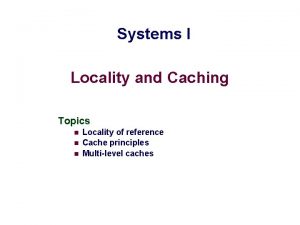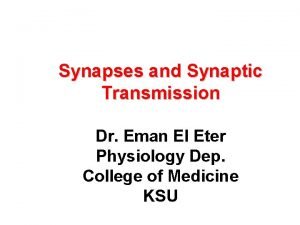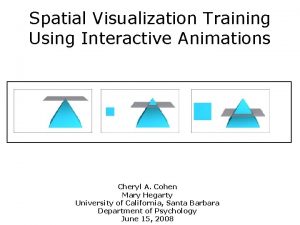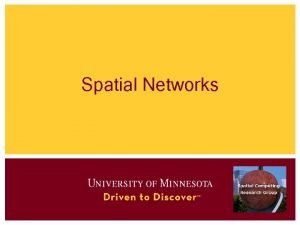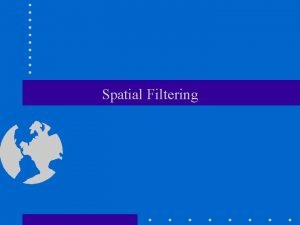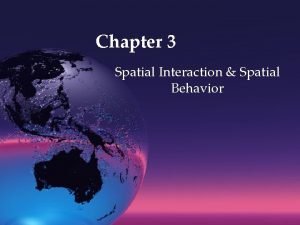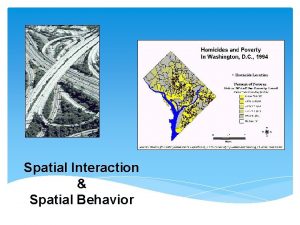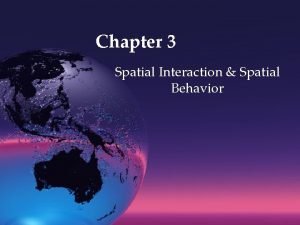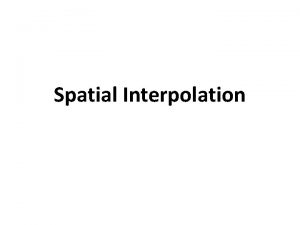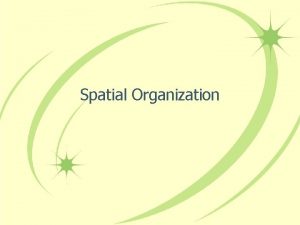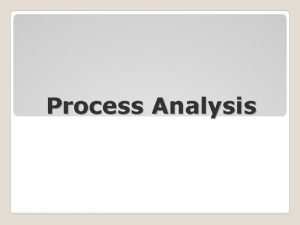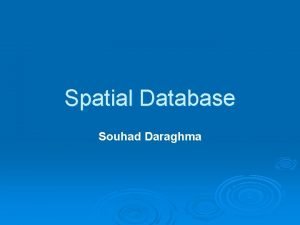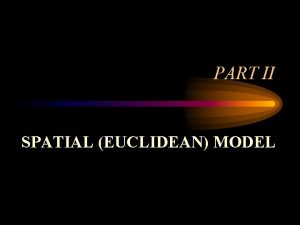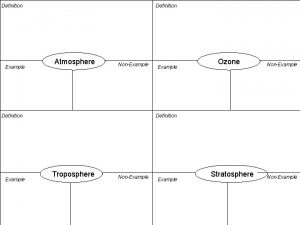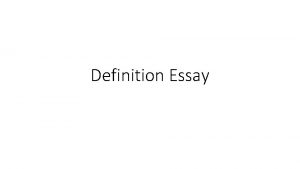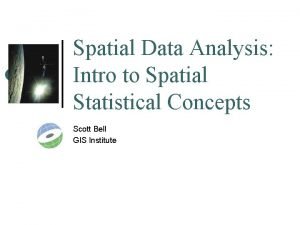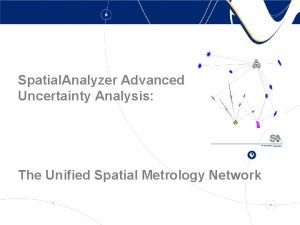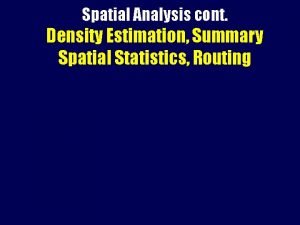Definition of Spatial Analysis Spatial analysis The process









































































- Slides: 73

Definition of Spatial Analysis Spatial analysis - The process of modeling, examining, and interpreting model results. Spatial analysis is useful for ◦ evaluating suitability and capability ◦ estimating and predicting ◦ interpreting and understanding

Spatial Analysis - cont. There are four traditional types of spatial analysis: ◦ ◦ Topological overlay and contiguity analysis Surface analysis Linear analysis Raster analysis Retrieval/classification/measurement Overlay (arithmetic, various conversions) Neighborhood Connectivity

Definition of Spatial Analysis Spatial data analysis involves the application of operations to coordinate and relate attribute data. Spatial analyses are applied to solve problems related to geographic decisions ◦ Identify high crime area ◦ Selection of a best location for a new business ◦ Extent of sage brush infestation in Idaho. ◦ Spread of a disease ◦ Etc…

Definition of Spatial Analysis - cont. Spatial operations could be applied sequentially ◦ An output could serve as input ◦ Sequence of spatial operations is important Bolstad, 2005

Definition of Spatial Analysis - cont. Bolstad, 2005 one input can have many outputs many inputs can have one output

Spatial Operations Local operations Neighborhood operations Global operations Bolstad, 2005

GIS Analysis Functions Four broad categories

1. Retrieval, Classification, & Measurement Functions Retrieval ◦ Selective Search Classification/Reclassification (Overlays, combine) ◦ Identifying a set of features as belonging to a group ◦ Defines patterns Measurement ◦ Distances, lengths, perimeters, areas

Selection operations ◦ Involve identifying features based on several conditions or criteria ◦ The attributes or geometry of features are checked against the conditions or criteria ◦ You can write the selected features into new output data layer ◦ You can use the selection for other analysis Examples

Select: 1. State = Arkansas 2. States = entirely north of Arkansas 3. States_area>84, 000 sq. mi. 4. States both entirely north of Arkansas and larger than 84, 000 sq. mi. Bolstad, 2005

Functions of Spatial Analysis Conditional selection ◦ Set Algebra Less than (<) Greater than (>) Equal to (=) Not equal to (<>) ◦ Boolean Algebra Conditions OR, AND, and NOT Bolstad, 2005

Examples of Expression in Boolean Algebra Bolstad, 2005

Select by Location - cont. Selecting options ◦ That Meet ◦ That Overlap ◦ That Contains ◦ That are Contained by ◦ That are Entirely Contained By ◦ That are Spatially Equal ◦ That Touch

Examples of Selection by Location States adjacent to Missouri Bolstad, 2005

Examples of Selection by Location - cont. States containing a portion of Mississippi River or its tributaries are selected Bolstad, 2005

Classification Categorization of geographic objects based on a set of conditions Also known as reclassification or recoding Spatial data operation can be used along with selection operation Example: classify polygons based on size Bolstad, 2005

Classification - cont. Classification is an operation to create a new group of classes from an existing set of classes Classification is governed by a a table or array (decided by user before hand) Bolstad, 2005

Classification - example Classification of land use for obtaining your required information

Classification - cont. Binary classification ◦ You need to have two classes 0 and 1 True or false A and B Some other two level classifications Bolstad, 2005

Automatic Classification Automatic classification ◦ Good for many classes in one feature file (when it is practically not possible to manually classify into groups) ◦ Requires classification schemes (algorithms or mathematical formula) which will combine various classes into a single group Equal interval Defined interval Natural breaks (Jenks) Standard deviation

Classification Examples Quantile classification Bolstad, 2005

Retrieval: Selective Search addresses selected because they fall within circle

Reclassification (Vector) Dissolving to aggregate polygons

Reclassify by Area Size Work with areas > 80 acres

Reclassify by Contiguity Work with individual forest stands, rather than the class forest as a whole.

Reclassify values Work with elevations between 20 and 40 feet Change feet to meters

Buffer one of the most common spatial analysis tools specific distance representation around a feature ◦ The distances can either be constant or can vary depending upon attribute values. ◦ When features are close together, their buffers may overlap. The user can choose to preserve the overlaps or remove them. The buffer operation creates a new polygon data set

Examples of Buffer Bolstad, 2005

Examples of Buffer

Vector Distance Operation: Buffers & Setbacks Diagram of simple buffers and a setback. NOTE: buffers go outward from lines or areas; setbacks run inside of areas (not lines). Image Source: Chrisman, Nicholas. (2002). 2 nd Ed. Exploring Geographic Information Systems. p 154. fig. 6 -1 .

Buffer Creation: Illustrated Image Source: Chrisman, Nicholas. (2002). 2 nd Ed. Exploring Geographic Information Systems. p 60. fig. 6 -3 .

2. Overlay Functions Arithmetic ◦ addition, subtraction, division, multiplication Logical ◦ find where specified conditions occur (and, or, >, <, etc. ) Raster & Vector methods differ ◦ Vector good for sparse data sets ◦ Raster grid calculations easier Overlay (demo – addition)

Overlay Another common spatial analysis tool Allows the user to identify areas where features in two layers overlap. A new data set is often created from these overlaps. ◦ In a Union Overlay, all features are Overlay included in the new data set but the features that overlap represent a new feature. ◦ In an Intersect Overlay, only the areas Overlay that overlap are contained in the new data set.

Overlay Example • Analysis Tools • select Overlay • Intersect tool • Analysis Tools • select Overlay • Union tool

Examples Bolstad, 2005

Overlay Example - cont. Vector overlay Bolstad, 2005

Overlay: Combining Attributes Select attributes of interest for a given location (Raster & vector methods do this differently, but the results are similar)

Vector based Overlay 3 main types of vector overlay ◦ point-in-polygon ◦ line-in-polygon ◦ polygon-on-polygon

Vector based overlay point-in-polygon example

Vector based overlay line-in-polygon example

Vector based overlay polygon-in-polygon example

Raster Based Overlay: Simple Addition Image Source: Chrisman, Nicholas. (2002). 2 nd Ed. Exploring Geographic Information Systems. p 144. fig. 5 -12 .

Raster Overlay: Boolean Combine Image Source: Chrisman, Nicholas. (2002). 2 nd Ed. Exploring Geographic Information Systems. p 125. fig. 5 -3 .

Raster Overlay: Composite Combine

Overlay Example - cont. Raster overlay

Vector Overlay: Composite Structure Image Source: Chrisman, Nicholas. (2002). 2 nd Ed. Exploring Geographic Information Systems. p 127. fig. 5 -5 .

3. Neighborhood Functions Basic Functions ◦ Average, diversity, majority, minimum/maximum, and total Parameters to define: ◦ Target location(s) ◦ Specification of neighborhood ◦ Function to perform on neighborhood elements

3. Neighborhood Function (cont) Search Operation ◦ most common neighborhood operation Example ◦ count the number of customers within 2 miles of the grocery store

3. Neighborhood Functions (cont) Point or Line in Polygon Operation ØVector Model specialized search function ØRaster Model polygons one data layer points or lines in separate data layer Buffers (demo - point, line, polygon)

Neighborhood Functions: 4 x 4 Window Processing

Neighborhood Functions: 4 X 4/Annulus/Circular/Wage Neighborhood Processing

Neighborhood Functions: Wedge Neighborhood Processing

4. Connectivity Functions Used to accumulate values over an area being navigated Parameters to define: ◦ specification of way spatial elements are connected ◦ rules that specify allowed movement along interconnections ◦ a unit of measurement

4. Connectivity Functions (cont). Proximity Operation ◦ measure of the distance between features ◦ not restricted to distance; can be noise, time, pollution, etc. Parameters to define: ◦ target location ◦ unit of measure ◦ function to calculate proximity (distance/time/noise) ◦ area to be analyzed

Example: Connectivity (Raster) Proximity Operation: Distance From Neighbor

Example: Connectivity (Vector) Proximity Operation: Road Buffer

4. Connectivity Functions (cont). Contiguity Operation ◦ spatial units are connected - defines “unbroken area” Contiguity measures: ◦ size of neighboring area(s) ◦ shortest/longest straight line distance across adjacent area(s) ◦ specific shape of neighboring area(s)

Contiguity Functions Combines adjacent units together when they share a common attribute

4. Connectivity Functions (cont). Network Operations ◦ set of interconnected lines that represent a set of features through which resources flow Common network functions ◦ shortest path problem (route optimization) ◦ location-allocation modeling (resource allocation) ◦ traveling salesperson problem (route optimization) ◦ route tracing (prediction of network loading)

Spread Function: Calculation of Distance

Spread Function: Equidistant Travel Zones from Target (A)

Emergency Services Real time tracking, route-finding, best to respond

4. Connectivity Functions (cont). Visibility Analysis Operations ◦ identification of areas of terrain that can be seen from a particular point on the surface Viewshed Operation ◦ uses digital elevation model data (DEMs) or. . . ◦ digital terrain model data (DTMs) or. . . ◦ triangulated irregular network data (TINs)

Connectivity Function Example: Viewshed Analysis Image Source: Chrisman, Nicholas. (2002). 2 nd Ed. Exploring Geographic Information Systems. p 198. fig. 8 -14 .

Viewshed aka Intervisibility

Environmental Impact Analysis 3 D landscape model impact on natural beauty

The 3 rd Dimension: Height Analysis Contours Hill shading Spot height symbols Cliff & slope symbols Viewpoint symbols

With Spatial Analysis Tools Use What You Can Do? Find suitable locations. Find the best path between locations. Perform distance and cost-of-travel analyses. Perform statistical analysis based on the local environment, small neighborhoods, or predetermined zones. Generate new data using simple image processing tools. Interpolate data values for a study area based on samples. Clean up a variety of data for further analysis or display.

Flood Risk 3 D height data changing water levels-danger areas

Derived Mapping: Data from images Numerical Values Color Representation

Derived Mapping: Data from images Aerial Imagery Digitized Buildings

Derived Mapping: Data from images Satellite Imagery Derived Area Map This is a goal: Not there yet!

Airport Noise Pollution noise complaints mapped by address location
 Oflinemaps
Oflinemaps Definition of spatial analysis
Definition of spatial analysis Hát kết hợp bộ gõ cơ thể
Hát kết hợp bộ gõ cơ thể Slidetodoc
Slidetodoc Bổ thể
Bổ thể Tỉ lệ cơ thể trẻ em
Tỉ lệ cơ thể trẻ em Gấu đi như thế nào
Gấu đi như thế nào Chụp tư thế worms-breton
Chụp tư thế worms-breton Hát lên người ơi alleluia
Hát lên người ơi alleluia Các môn thể thao bắt đầu bằng tiếng chạy
Các môn thể thao bắt đầu bằng tiếng chạy Thế nào là hệ số cao nhất
Thế nào là hệ số cao nhất Các châu lục và đại dương trên thế giới
Các châu lục và đại dương trên thế giới Công thức tính độ biến thiên đông lượng
Công thức tính độ biến thiên đông lượng Trời xanh đây là của chúng ta thể thơ
Trời xanh đây là của chúng ta thể thơ Cách giải mật thư tọa độ
Cách giải mật thư tọa độ Làm thế nào để 102-1=99
Làm thế nào để 102-1=99 độ dài liên kết
độ dài liên kết Các châu lục và đại dương trên thế giới
Các châu lục và đại dương trên thế giới Thơ thất ngôn tứ tuyệt đường luật
Thơ thất ngôn tứ tuyệt đường luật Quá trình desamine hóa có thể tạo ra
Quá trình desamine hóa có thể tạo ra Một số thể thơ truyền thống
Một số thể thơ truyền thống Cái miệng nó xinh thế
Cái miệng nó xinh thế Vẽ hình chiếu vuông góc của vật thể sau
Vẽ hình chiếu vuông góc của vật thể sau Biện pháp chống mỏi cơ
Biện pháp chống mỏi cơ đặc điểm cơ thể của người tối cổ
đặc điểm cơ thể của người tối cổ V cc
V cc Vẽ hình chiếu đứng bằng cạnh của vật thể
Vẽ hình chiếu đứng bằng cạnh của vật thể Vẽ hình chiếu vuông góc của vật thể sau
Vẽ hình chiếu vuông góc của vật thể sau Thẻ vin
Thẻ vin đại từ thay thế
đại từ thay thế điện thế nghỉ
điện thế nghỉ Tư thế ngồi viết
Tư thế ngồi viết Diễn thế sinh thái là
Diễn thế sinh thái là Dot
Dot Bảng số nguyên tố
Bảng số nguyên tố Tư thế ngồi viết
Tư thế ngồi viết Lời thề hippocrates
Lời thề hippocrates Thiếu nhi thế giới liên hoan
Thiếu nhi thế giới liên hoan ưu thế lai là gì
ưu thế lai là gì Hươu thường đẻ mỗi lứa mấy con
Hươu thường đẻ mỗi lứa mấy con Khi nào hổ con có thể sống độc lập
Khi nào hổ con có thể sống độc lập Sơ đồ cơ thể người
Sơ đồ cơ thể người Từ ngữ thể hiện lòng nhân hậu
Từ ngữ thể hiện lòng nhân hậu Thế nào là mạng điện lắp đặt kiểu nổi
Thế nào là mạng điện lắp đặt kiểu nổi Spatial analysis questions
Spatial analysis questions Spatial design network analysis
Spatial design network analysis Centre for advanced spatial analysis
Centre for advanced spatial analysis R and gis
R and gis Spatial attention definition
Spatial attention definition Spatial reorganization definition
Spatial reorganization definition Types of diffusion ap human
Types of diffusion ap human Process analysis definition
Process analysis definition Os coxae
Os coxae Liberty chapter 20
Liberty chapter 20 Process hierarchy in process management
Process hierarchy in process management Ergodicty
Ergodicty What is process to process delivery
What is process to process delivery Condylar process and coronoid process
Condylar process and coronoid process Stable quality
Stable quality Process-to-process delivery
Process-to-process delivery Sweet process review
Sweet process review Sweet evaluation
Sweet evaluation Visual spatial relations
Visual spatial relations Township and range aphg
Township and range aphg Master asl unit 7
Master asl unit 7 Spatial data and attribute data
Spatial data and attribute data Text structure spatial
Text structure spatial Organizational patterns text structure
Organizational patterns text structure Spatial text structure
Spatial text structure Temporal locality
Temporal locality Temporal summation example
Temporal summation example Spatial visualization training
Spatial visualization training Spatial outline
Spatial outline Spatial mask
Spatial mask

